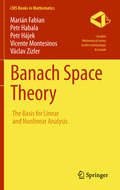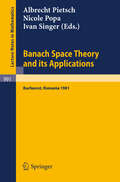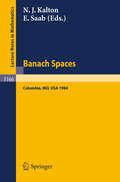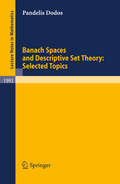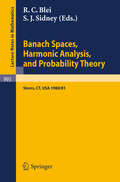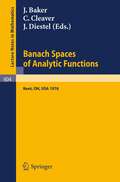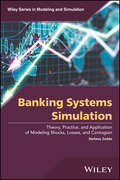- Table View
- List View
Banach-Space Operators On C*-Probability Spaces Generated by Multi Semicircular Elements (Chapman & Hall/CRC Monographs and Research Notes in Mathematics)
by Ilwoo ChoBanach-Space Operators On C*-Probability Spaces Generated by Multi Semicircular Elements introduces new areas in operator theory and operator algebra, in connection with free probability theory. In particular, the book considers projections and partial isometries distorting original free-distributional data on the C∗-probability spaces. Features Suitable for graduate students and professional researchers in operator theory and/or analysis. Numerous applications in related scientific fields and areas
Banach-Space Operators On C*-Probability Spaces Generated by Multi Semicircular Elements (Chapman & Hall/CRC Monographs and Research Notes in Mathematics)
by Ilwoo ChoBanach-Space Operators On C*-Probability Spaces Generated by Multi Semicircular Elements introduces new areas in operator theory and operator algebra, in connection with free probability theory. In particular, the book considers projections and partial isometries distorting original free-distributional data on the C∗-probability spaces. Features Suitable for graduate students and professional researchers in operator theory and/or analysis. Numerous applications in related scientific fields and areas
Banach Space Theory: The Basis for Linear and Nonlinear Analysis (CMS Books in Mathematics)
by Marián Fabian Petr Habala Petr Hájek Vicente Montesinos Václav ZizlerBanach spaces provide a framework for linear and nonlinear functional analysis, operator theory, abstract analysis, probability, optimization and other branches of mathematics. This book introduces the reader to linear functional analysis and to related parts of infinite-dimensional Banach space theory. Key Features: - Develops classical theory, including weak topologies, locally convex space, Schauder bases and compact operator theory - Covers Radon-Nikodým property, finite-dimensional spaces and local theory on tensor products - Contains sections on uniform homeomorphisms and non-linear theory, Rosenthal's L1 theorem, fixed points, and more - Includes information about further topics and directions of research and some open problems at the end of each chapter - Provides numerous exercises for practice The text is suitable for graduate courses or for independent study. Prerequisites include basic courses in calculus and linear. Researchers in functional analysis will also benefit for this book as it can serve as a reference book.
Banach Space Theory and its Applications: Proceedings of the First Romanian GDR Seminar Held at Bucharest, Romania, August 31 - September 6, 1981 (Lecture Notes in Mathematics #991)
by A. Pietsch N. Popa I. SingerBanach Spaces: Proceedings of the Missouri Conference held in Columbia, USA, June 24-29, 1984 (Lecture Notes in Mathematics #1166)
by Nigel J. Kalton Elias SaabBanach Spaces and Descriptive Set Theory: Selected Topics (Lecture Notes in Mathematics #1993)
by Pandelis DodosThese notes are devoted to the study of some classical problems in the Geometry of Banach spaces. The novelty lies in the fact that their solution relies heavily on techniques coming from Descriptive Set Theory. Thecentralthemeisuniversalityproblems.Inparticular,thetextprovides an exposition of the methods developed recently in order to treat questions of the following type: (Q) LetC be a class of separable Banach spaces such that every space X in the classC has a certain property, say property (P). When can we ?nd a separable Banach space Y which has property (P) and contains an isomorphic copy of every member ofC? We will consider quite classical properties of Banach spaces, such as “- ing re?exive,” “having separable dual,” “not containing an isomorphic copy of c ,” “being non-universal,” etc. 0 It turns out that a positive answer to problem (Q), for any of the above mentioned properties, is possible if (and essentially only if) the classC is “simple.” The “simplicity” ofC is measured in set theoretic terms. Precisely, if the classC is analytic in a natural “coding” of separable Banach spaces, then we can indeed ?nd a separable space Y which is universal for the class C and satis?es the requirements imposed above.
Banach Spaces, Harmonic Analysis, and Probability Theory: Proceedings of the Special Year in Analysis, held at the University of Connecticut 1980-1981 (Lecture Notes in Mathematics #995)
by R. C. Blei S. J. SidneyBanach Spaces of Analytic Functions.: Proceedings of the Pelzczynski Conference Held at Kent State University, July 12-16, 1976. (Lecture Notes in Mathematics #604)
by G. Bennett S. Y. Chang D. E. Marshall J. A. Cima W. Davis W. J. Davis W. B. Johnson J. B. Garnett J. Johnson J. Wolfe H. E. Lacey D. R. Lewis A. L. Matheson P. Orno J. W. Roberts R. Rochberg B. Russo S. Scheinberg J. H. Shapiro M. A. Smith F. Sullivan C. StegallWith contributions by numerous experts
Banach Spaces of Continuous Functions as Dual Spaces (CMS Books in Mathematics)
by H. G. Dales F.K. Dashiell, Jr. A.T.-M. Lau D. StraussThis book gives a coherent account of the theory of Banach spaces and Banach lattices, using the spaces C_0(K) of continuous functions on a locally compact space K as the main example. The study of C_0(K) has been an important area of functional analysis for many years. It gives several new constructions, some involving Boolean rings, of this space as well as many results on the Stonean space of Boolean rings. The book also discusses when Banach spaces of continuous functions are dual spaces and when they are bidual spaces.
Banach Spaces of Vector-Valued Functions (Lecture Notes in Mathematics #1676)
by Pilar Cembranos Jose Mendoza"When do the Lebesgue-Bochner function spaces contain a copy or a complemented copy of any of the classical sequence spaces?" This problem and the analogous one for vector- valued continuous function spaces have attracted quite a lot of research activity in the last twenty-five years. The aim of this monograph is to give a detailed exposition of the answers to these questions, providing a unified and self-contained treatment. It presents a great number of results, methods and techniques, which are useful for any researcher in Banach spaces and, in general, in Functional Analysis. This book is written at a graduate student level, assuming the basics in Banach space theory.
Bank Management and Control: Strategy, Capital and Risk Management (Management for Professionals)
by Johannes WernzStrategic planning, including the required quantitative methods, is an essential part of bank management and control. In this book capital, risk and yield are treated comprehensively and seamlessly. And a thorough introduction to the advanced methods of risk management for all sectors of banking is discussed. In addition, directly applicable concepts and data such as macroeconomic scenarios for strategic planning and stress testing as well as detailed scenarios for operational risk and advanced concepts for credit risk are presented in straightforward language. The book analyzes the effects of macroeconomic and regulatory developments such as the set of Basel III rules on planning, and it also presents and discusses the consequences for actively meeting these challenges, especially in terms of capital. A wealth of essential background information from practice, international observations and comparisons, along with numerous illustrative examples, make this book a useful resource for established and future professionals in bank management, risk/return management, controlling and accounting.
Bank Management and Control: Strategy, Pricing, Capital and Risk Management (Management for Professionals)
by Johannes WernzThis book discusses risk management, product pricing, capital management and Return on Equity comprehensively and seamlessly. Strategic planning, including the required quantitative methods, is an essential part of bank management and control. A thorough introduction to the advanced methods of risk management for Credit Risk, Counterparty Credit Risk, Market Risk, Operational Risk and Risk Aggregation is provided. In addition, directly applicable concepts and data such as macroeconomic scenarios for strategic planning and stress testing as well as detailed scenarios for Operational Risk and advanced concepts for Credit Risk are presented in straightforward language. The book highlights the implications and chances of the Basel III and Basel IV implementations (2022 onwards), especially in terms of capital management and Return on Equity. A wealth of essential background information from practice, international observations and comparisons, along with numerous illustrative examples, make this book a useful resource for established and future professionals in bank management, risk management, capital management, controlling and accounting.
Banking Beyond Banks and Money: A Guide to Banking Services in the Twenty-First Century (New Economic Windows)
by Paolo Tasca Tomaso Aste Loriana Pelizzon Nicolas PeronyDo you know how banking and money will look like in the new digital age?This book collects the voices of leading scholars, entrepreneurs, policy makers and consultants who, through their expertise and keen analytical skills, are best positioned to picture from various angles the ongoing technological revolution in banking and finance.You will learn how lending and borrowing can exist without banks; how new forms of money can compete to better serve different society needs; how new technologies are banking the unbanked communities in the poorest parts of the world, and how ideas and small projects can be financed by the crowds without the need to rely upon banks. You will learn how, in the new digital age, we will interact with new self-organised and autonomous companies that operate without any human involvement, based on a set of programmed and incorruptible rules. You will learn that new business models will emerge thanks to technology-enabled platforms, upon which one can build new forms of non-hierarchical cooperation between strangers. And you will also learn that new forms of risks and threats are emerging that will destabilise our systems and jeopardise the stability of our financial order.
Banking Systems Simulation: Theory, Practice, and Application of Modeling Shocks, Losses, and Contagion (Wiley Series in Modeling and Simulation)
by Stefano ZeddaPresents information sources and methodologies for modeling and simulating banking system stability Combining both academic and institutional knowledge and experience, Banking Systems Simulation: Theory, Practice, and Application of Modeling Shocks, Losses, and Contagion presents banking system risk modeling clearly within a theoretical framework. Written from the global financial perspective, the book explores single bank risk, common bank exposures, and contagion, and how these apply on a systemic level. Zedda approaches these simulation methods logically by providing the basic building blocks of modeling and simulation, and then delving further into the individual techniques that make up a systems model. In addition, the author provides clear and detailed explanations of the foundational research into the mathematical and legal concepts used to analyze banking risk problems, measures and data for representing the main banking risk sources, and the major problems researchers are likely to encounter. There are numerous software descriptions throughout, with references and tools to help readers gain a proper understanding of the presented techniques and possibly develop new applications and research. The book concludes with an appendix that features real-world datasets and models. In addition, this book: • Provides a comprehensive overview of methods for analyzing models and simulating risk for banking and financial systems • Provides a clear presentation of the technical and legal concepts used in banking regulation • Presents unique insights from an expert’s perspective, with specific coverage of assessing risks and developing what-if analyses at the systems level • Concludes with a discussion of applications, including banking systems regulation what-if tests, cost-benefit analysis, evaluations of banking systems stability effects on public finances, dimensioning, and risk-based contributions for Deposit Guarantee Schemes (DGS) and Resolution Funds Banking Systems Simulation: Theory, Practice, and Application of Modeling Shocks, Losses, and Contagion is ideal for banking researchers focusing on computational methods of analysis as well as an appropriate reference for graduate-level students in banking, finance, and computational methods. Stefano Zedda is Researcher in Financial Mathematics at the University of Cagliari in Italy and qualified as associate professor in banking and corporate finance. His research is mainly focused on quantitative analyses for banking and finance, with a particular focus on banking systems modeling and simulation. In 2008, Zedda developed the mathematical modeling and software implementation of the Systemic Model for Banking Originated Losses (SYMBOL), further developed during his activity at the European Commission. The Commission subsequently adopted it as a standard tool for testing banking regulation proposals. Stefano Zedda’s research interests include banking, financial mathematics, and statistics, specifically simulation of banking and financial systems stability, banking regulation impact assessment, and interactive agent simulation.
Banking Systems Simulation: Theory, Practice, and Application of Modeling Shocks, Losses, and Contagion (Wiley Series in Modeling and Simulation)
by Stefano ZeddaPresents information sources and methodologies for modeling and simulating banking system stability Combining both academic and institutional knowledge and experience, Banking Systems Simulation: Theory, Practice, and Application of Modeling Shocks, Losses, and Contagion presents banking system risk modeling clearly within a theoretical framework. Written from the global financial perspective, the book explores single bank risk, common bank exposures, and contagion, and how these apply on a systemic level. Zedda approaches these simulation methods logically by providing the basic building blocks of modeling and simulation, and then delving further into the individual techniques that make up a systems model. In addition, the author provides clear and detailed explanations of the foundational research into the mathematical and legal concepts used to analyze banking risk problems, measures and data for representing the main banking risk sources, and the major problems researchers are likely to encounter. There are numerous software descriptions throughout, with references and tools to help readers gain a proper understanding of the presented techniques and possibly develop new applications and research. The book concludes with an appendix that features real-world datasets and models. In addition, this book: • Provides a comprehensive overview of methods for analyzing models and simulating risk for banking and financial systems • Provides a clear presentation of the technical and legal concepts used in banking regulation • Presents unique insights from an expert’s perspective, with specific coverage of assessing risks and developing what-if analyses at the systems level • Concludes with a discussion of applications, including banking systems regulation what-if tests, cost-benefit analysis, evaluations of banking systems stability effects on public finances, dimensioning, and risk-based contributions for Deposit Guarantee Schemes (DGS) and Resolution Funds Banking Systems Simulation: Theory, Practice, and Application of Modeling Shocks, Losses, and Contagion is ideal for banking researchers focusing on computational methods of analysis as well as an appropriate reference for graduate-level students in banking, finance, and computational methods. Stefano Zedda is Researcher in Financial Mathematics at the University of Cagliari in Italy and qualified as associate professor in banking and corporate finance. His research is mainly focused on quantitative analyses for banking and finance, with a particular focus on banking systems modeling and simulation. In 2008, Zedda developed the mathematical modeling and software implementation of the Systemic Model for Banking Originated Losses (SYMBOL), further developed during his activity at the European Commission. The Commission subsequently adopted it as a standard tool for testing banking regulation proposals. Stefano Zedda’s research interests include banking, financial mathematics, and statistics, specifically simulation of banking and financial systems stability, banking regulation impact assessment, and interactive agent simulation.
Bankruptcy Prediction through Soft Computing based Deep Learning Technique
by Arindam Chaudhuri Soumya K GhoshThis book proposes complex hierarchical deep architectures (HDA) for predicting bankruptcy, a topical issue for business and corporate institutions that in the past has been tackled using statistical, market-based and machine-intelligence prediction models. The HDA are formed through fuzzy rough tensor deep staking networks (FRTDSN) with structured, hierarchical rough Bayesian (HRB) models. FRTDSN is formalized through TDSN and fuzzy rough sets, and HRB is formed by incorporating probabilistic rough sets in structured hierarchical Bayesian model. Then FRTDSN is integrated with HRB to form the compound FRTDSN-HRB model. HRB enhances the prediction accuracy of FRTDSN-HRB model. The experimental datasets are adopted from Korean construction companies and American and European non-financial companies, and the research presented focuses on the impact of choice of cut-off points, sampling procedures and business cycle on the accuracy of bankruptcy prediction models. The book also highlights the fact that misclassification can result in erroneous predictions leading to prohibitive costs to investors and the economy, and shows that choice of cut-off point and sampling procedures affect rankings of various models. It also suggests that empirical cut-off points estimated from training samples result in the lowest misclassification costs for all the models. The book confirms that FRTDSN-HRB achieves superior performance compared to other statistical and soft-computing models. The experimental results are given in terms of several important statistical parameters revolving different business cycles and sub-cycles for the datasets considered and are of immense benefit to researchers working in this area.
A bar chart (large print)
by RnibThis diagram shows a generic bar chart. There is a locator dot shown, which will be at the top left of the page when the image is the right way up. There are five vertical bars plotted. The x-axis at the bottom of the page is labelled from 0 to 5. The y-axis on the left of the page is labelled from 0 to 8. Each point on the y-axis has a dotted horizontal gridline extending across the page. Each bar on the graph represents a different value and is therefore a different height, with the lowest reaching 1 on the y-axis and the highest reaching 7 on the y-axis.
Bar chart (large print)
by RnibThis page shows a bar chart type of graph. There is a locator dot shown, which will be at the top left, when the image is the correct way up. The Y-axis on the left of the page is the number of newspapers sold. It is numbered every ten papers and there are gridlines every five newspapers. The X-axis at the bottom of the page shows the days of the week from Monday to Saturday. The days are abbreviated to the first three letters of the day. There is a small key in the bottom left of the page explaining the two different newspapers sold each day. The sales of the newspapers are represented by vertical bars on the chart.
Bar chart (UEB contracted)
by RnibThis page shows a bar chart type of graph. There is a locator dot shown, which will be at the top left, when the image is the correct way up. The Y-axis on the left of the page is the number of newspapers sold. It is numbered every ten papers and there are gridlines every five newspapers. The X-axis at the bottom of the page shows the days of the week from Monday to Saturday. The days are abbreviated to the first three letters of the day. There is a small key in the bottom left of the page explaining the two different newspapers sold each day. The sales of the newspapers are represented by vertical bars on the chart.
A bar chart (UEB uncontracted)
by RnibThis diagram shows a generic bar chart. There is a locator dot shown, which will be at the top left of the page when the image is the right way up. There are five vertical bars plotted. The x-axis at the bottom of the page is labelled from 0 to 5. The y-axis on the left of the page is labelled from 0 to 8. Each point on the y-axis has a dotted horizontal gridline extending across the page. Each bar on the graph represents a different value and is therefore a different height, with the lowest reaching 1 on the y-axis and the highest reaching 7 on the y-axis.
A bar chart (UEB uncontracted)
by RnibThis diagram shows a generic bar chart. There is a locator dot shown, which will be at the top left of the page when the image is the right way up. There are five vertical bars plotted. The x-axis at the bottom of the page is labelled from 0 to 5. The y-axis on the left of the page is labelled from 0 to 8. Each point on the y-axis has a dotted horizontal gridline extending across the page. Each bar on the graph represents a different value and is therefore a different height, with the lowest reaching 1 on the y-axis and the highest reaching 7 on the y-axis.
Bar chart (UEB uncontracted)
by RnibThis page shows a bar chart type of graph. There is a locator dot shown, which will be at the top left, when the image is the correct way up. The Y-axis on the left of the page is the number of newspapers sold. It is numbered every ten papers and there are gridlines every five newspapers. The X-axis at the bottom of the page shows the days of the week from Monday to Saturday. The days are abbreviated to the first three letters of the day. There is a small key in the bottom left of the page explaining the two different newspapers sold each day. The sales of the newspapers are represented by vertical bars on the chart.
Bar graph example (large print)
by RnibOn this page there is a labelled bar graph plotting number of people against shoe size. There is a locator dot shown, which will be at the top left of the page when the image is the right way up. The Y-axis is on the left and shows the number of people. It is labelled every two units from zero at the bottom to ten at the top of the page. There are fine lines across the page every two units. The X-axis runs along the bottom of the page and shows shoe sizes from two to ten. For every shoe size there is a rectangular bar going up the page to show the number of people with this shoe size.
Bar graph example (UEB contracted)
by RnibOn this page there is a labelled bar graph plotting number of people against shoe size. There is a locator dot shown, which will be at the top left of the page when the image is the right way up. The Y-axis is on the left and shows the number of people. It is labelled every two units from zero at the bottom to ten at the top of the page. There are fine lines across the page every two units. The X-axis runs along the bottom of the page and shows shoe sizes from two to ten. For every shoe size there is a rectangular bar going up the page to show the number of people with this shoe size.
Bar graph example (UEB uncontracted)
by RnibOn this page there is a labelled bar graph plotting number of people against shoe size. There is a locator dot shown, which will be at the top left of the page when the image is the right way up. The Y-axis is on the left and shows the number of people. It is labelled every two units from zero at the bottom to ten at the top of the page. There are fine lines across the page every two units. The X-axis runs along the bottom of the page and shows shoe sizes from two to ten. For every shoe size there is a rectangular bar going up the page to show the number of people with this shoe size.

